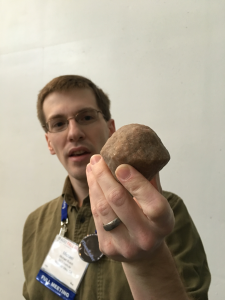16 December 2015
Problematic asteroids could be pushed off course by gentle thrusts
Posted by lhwang
by Brendan Bane

When asked about his research, Busch pulled out his go-to prop, which looks like a deformed muffin. But Busch’s prop isn’t a pastry — it’s a 3D-printed model of a 1300-foot-wide asteroid known as 2008 EV5, which could help astronomers test a technique in deflecting orbiting objects that drift dangerously close to Earth.
Credit: Michael Busch
When faced with the threat of large Earth-bound asteroids, some have suggested deflecting the rocky bodies by striking them with large objects. Others prefer to nuke them. But planetary astronomer Michael Busch takes a less violent approach: he suggests we deflect dangerous asteroids without ever touching them.
Busch, an astronomer at the Search for Extraterrestrial Intelligence (SETI) Institute in Mountain View, California, studies gravity tractors: special spacecraft designed to pull problem asteroids away from destructive trajectories and onto benign paths. He said the technology could come alive within the next decade through NASA’s Asteroid Redirect Mission. Busch presented his team’s research on gravity tractors at the 2015 American Geophysical Union Fall Meeting in San Francisco.
By flying a spacecraft close to an asteroid, Busch explained, scientists could exploit gravitational attraction between the two bodies to tease the object off its path. The technique begins with a mostly autonomous spacecraft, which hovers close beside the problem asteroid. Cameras aboard the vessel help astronomers measure the asteroid’s size, spin, and speed. By shifting its own course with low, gentle thrusts over the span of months or even years, a gravity tractor could shift a problem asteroid’s path by planet-sized distances.
But redirecting asteroids is a gentle art, Busch said. “We have to be very careful to consider all the complicated dynamics of objects flying around the solar system when you talk about moving them,” he said. Hover too close to an asteroid and you could crash an expensive spacecraft. Thrust too hard and the vessel will fly too far from the asteroid, breaking its gravitational influence. Each asteroid has its own unique shape, speed and spin, all of which determine how best to pull it off course, Busch said.
Busch may get to see gravity tractors in action after 2020, should the U.S. congress approve funding for NASA’S Asteroid Redirect Mission (ARM) early next year. If ARM goes live, its spacecraft will approach an asteroid known as 2008 EV5, snatch a boulder from its surface, and place the rock into our moon’s orbit. Astronauts could then visit and study the boulder by 2025. But before the ARM spacecraft departs from EV5, the two will hover together for six months, where the vessel will act as a gravity tractor by guiding the asteroid off its course. If ARM is approved and launches on time, Busch said, 2008 EV5 will be the first asteroid moved by gravity tractor deflection.
– Brendan Bane is a science communication graduate student at UC Santa Cruz. You can follow him on twitter at @brendan_bane.


 GeoSpace is a blog on Earth and space science, managed by AGU’s Public Information staff. The blog features posts by AGU writers and guest contributors on all sorts of relevant science topics, but with a focus on new research and geo and space sciences-related stories that are currently in the news.
GeoSpace is a blog on Earth and space science, managed by AGU’s Public Information staff. The blog features posts by AGU writers and guest contributors on all sorts of relevant science topics, but with a focus on new research and geo and space sciences-related stories that are currently in the news.